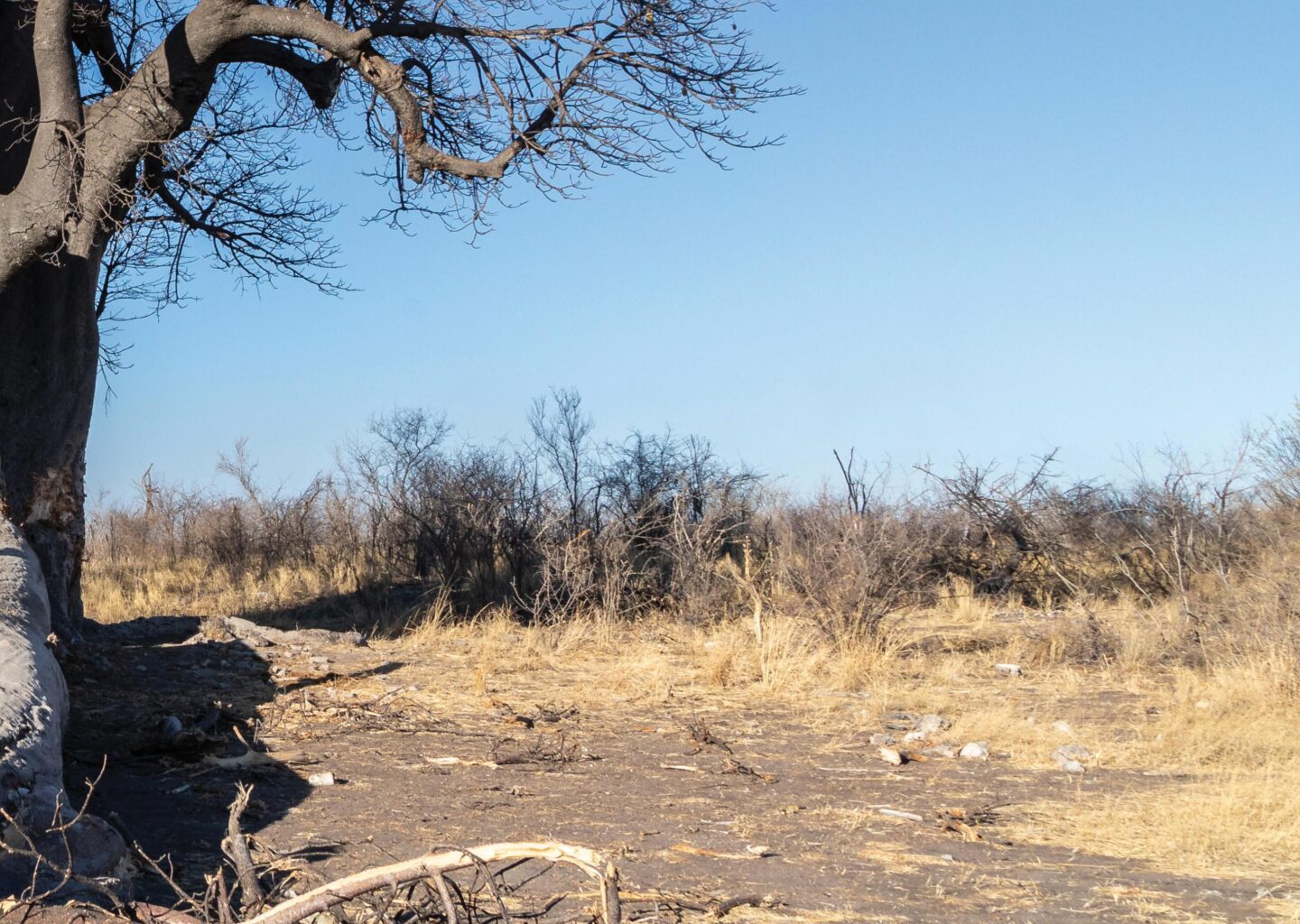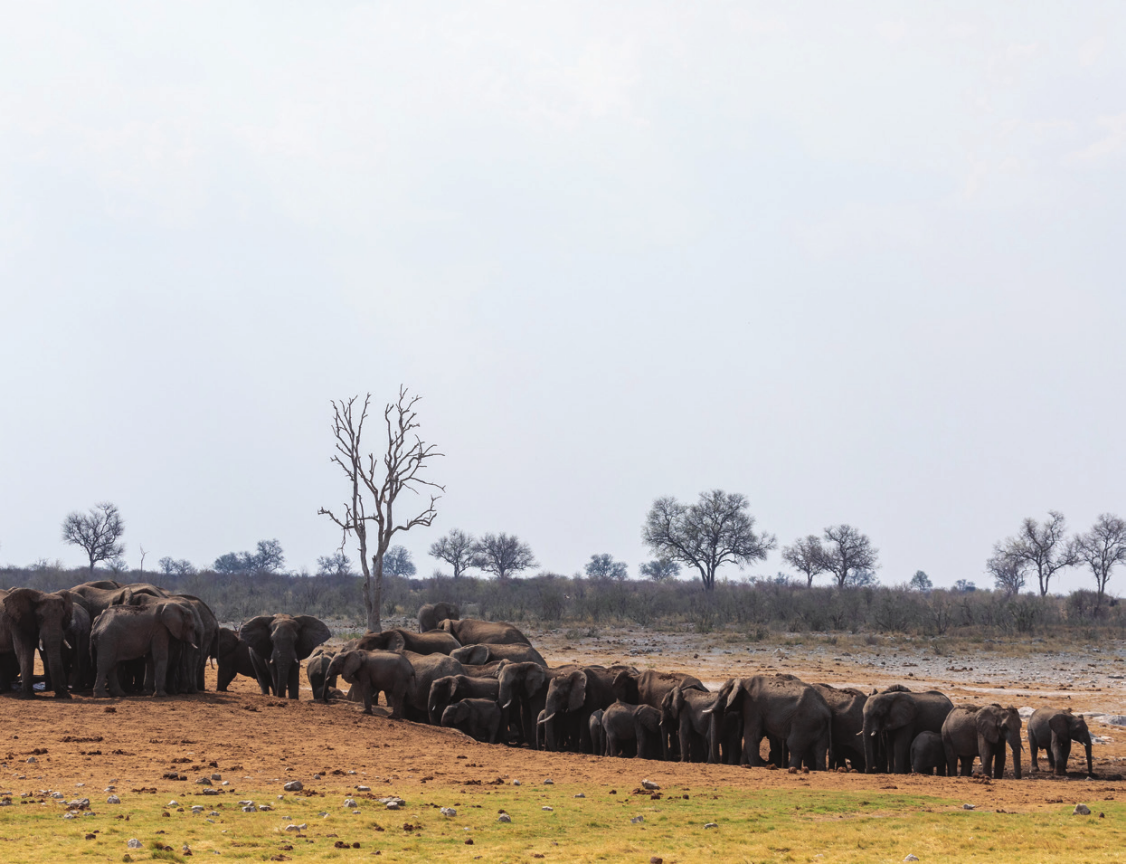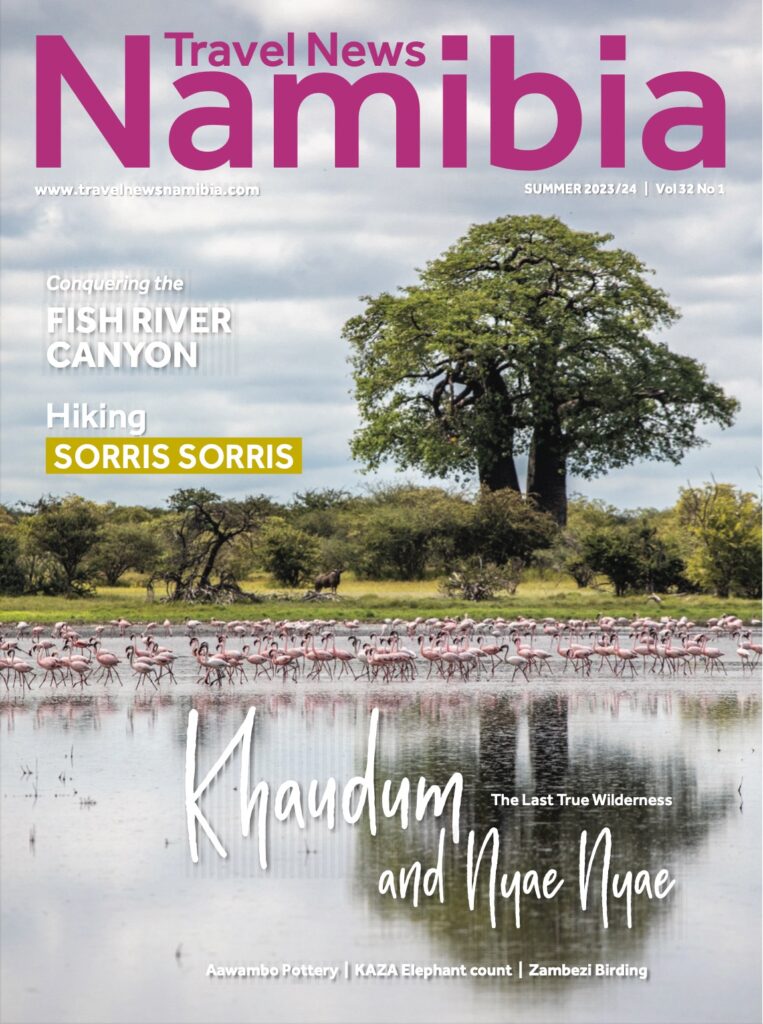

BACK TO BASICS
An untamed adventure in Namibia’s northeast
The juxtaposition of Namibia’s landscapes continues to leave me speechless. The northwest, characterised by rocky flat-top and pointy mountains cascading into valleys and then rivers. The deep south, where standing on a hilltop has you overlooking endless stretches of deserted plains. Our coastline, misty and magical, where gemsbok occasionally stroll on the beach. The fingertip of the Caprivi, lined by wondrous waterways, lush greenery and punctuated by rural villages.
Text Charene Labuschagne | Photographs Le Roux van Schalkwyk
From the Summer 2023/24 issue
And then there is the northeast. Rugged bushveld, baobabs the size of cathedrals, powdery dust, deep jeep tracks and San communities living so simplistically, it’s almost poetic. “Off the beaten track” may have become a bit of a cliché, but Bushmanland and Khaudum truly is an untapped and untamed adventure unlike any other place.
BUSHMANLAND
We began our adventure with a series of baobab camps in the Nyae Nyae conservancy. This splendid and wild land stretches south from the tiny settlement of Tsumkwe to the veterinary cordon fence at Gam. Speckled with pans that flood after good rains, traversing the area involves lazily cruising at low speed through thick vegetation until you grow weary of bushes. Then a baobab pops up into view, and an ice-cold beer in its shade is on the agenda.
Colloquially called the upside-down tree, baobabs are centuries old and resemble an intricate tapestry of taproots for branches. Their fat trunks bulge in all directions and on them the texture of folds and lumps tell fables of aeons of existence. It’s not only my favourite tree in Namibia, but seemingly that of elephants as well. Alongside the natural stretch marks of the trees are deep etched lines and crevices, where the dried fibres of the baobab become exposed from regular bum scratches and the occasional razor-sharp slice of a tusk. Standing in the skyscraper-high tree’s shadow and lifting your gaze up to the markings entirely out of reach, the mind inevitably paints a picture of the sheer size of the northeast’s elephants.
Along the M113 gravel road, inconspicuous little signs mark the turn into the untamed. These repurposed iron boards are hand-painted and either held up by wooden posts, or nonchalantly propped up against a rock on the ground. Blink, and you’ll overlook the endearing, occasionally misspelt signs to a “campside”. Our first detour from the main road on the Baobab Trail led to Gamsa Pan, where dense bushveld gave way to an open expanse of miraging white sand, and the first of many elephant herds kept us company while we sluggishly crept across the pan’s edge.
In this wilderness, elephants have the right of way. Nothing impedes on a holiday like haste and the nerve-wracking consequences of misreading wind direction and distance from a herd, leaving travellers at the mercy of an aggravated two-tonne mammal. Take your time, switch off the car engine and give in to the sweat droplets on your upper lip. And at the next pan, where even more elephants await, do it all again in the
name of adventure.
Setting up camp on our first night, we saw a crèche herd of ellies slurping up what remained of the scarce water in the second pan we discovered. Around a beautiful baobab the ground is cleared for tents and cars, a long-drop loo and bucket shower within sight, while a built fireplace and braai grid beckons for the company of camping chairs and the smoke signal of a dinner in the making. As dusk fades into night, a near full moon illuminates the treeline where silhouettes of the thirst-quenched elephants move along in a row, with only the occasional huff, puff and branch break filling the otherwise silent evening air.
To me, holiday is epitomised by waking up with the sun, taking a moment to stare out of a tent window with sleepy eyes, then hitting the proverbial snooze button until the heat forces you out of the sleeping quarters to make a coffee. This ritual is ideally followed by leisurely reading your book, observing birds around the campsite, and a freshening up for the day. We departed our campsites around 10 or 11 every day, just before it gets a little too hot and you find yourself playing musical chairs to chase the shade around a tree.
Trekking through ever denser bushveld on our second day along the Baobab Trail of Nyae Nyae, one would expect the scenery to grow a little tiresome. Yet, every bend into shrub-lined jeep tracks is as exhilarating as the first, every Lilac-breasted Roller a remarkable sighting, albeit a common one, and the preemptive signs of a small village approaching – like a stray goat, dog or row of rustic fencing – a delight. Overnighting at one of the
community campsites, you are guaranteed to meet a local. Often, such “manager” is appointed by the village for speaking decent English, and arrives at unpredictable times – sometimes with an entourage – with an invoice booklet in one hand and an activity brochure in the other. The ladies of the village offer guided food foraging excursions, interactive homemaking presentations and the opportunity to buy their meticulously created jewellery and crafts, while the entire group chimes in for dance performances, welcomes and goodbyes. Even if the trail to the demarcated campsite does not pass the village, through the thicket one can always tell roughly where it is, be it from the sound of children laughing or drums at sunset.
Our adventure passed through a quaint village of about 80 residents, where barefoot kids played in the sand and elders conversed under a tree. We had passed quite a few rather dire villages at this point, so the sight of this settlement’s thriving vegetable garden was welcome. A gentleman with deep laugh lines and an even deeper frown sat upright on a plastic chair when we asked what they were growing in the garden. “Food for my family,” he said plainly. I urge you to take a moment out of your day to spend with the village headman or embark on one of their activities – not for charity or sympathy, but because there is so much simplistic wisdom and wholehearted respect to be gained from and for the San.
KHAUDUM
Refuelling in Tsumkwe on both beer and petrol, we set out northwest to the unsung Namibian national park of Khaudum. It’s a wide detour from most self-drive itineraries, leaving you and your convoy to be the only people on a jeep track to seemingly nowhere. Khaudum should never be ventured alone. The soft off-white sand is deeply trodden, so at the very least two cars are necessary to make the expedition from Sikereti in the south, through the park to Khaudum Camp in the northern part, or vice versa. Should you get stuck, disembark, assess, deflate your tires, grab a refreshment, and proceed with a towing manoeuvre.
If you’re ever concerned about the elephant population of Southern Africa, a visit to Khaudum will assure you of their bounty. If not through observing large herds at water holes, then the sight of disturbed vegetation lining a beautifully bumpy track with a near-metre-high middleman should convince you.
Our group spent the first night camping at Sikereti, where lanky trees and the auburn hue of leaves from winter passed clear to grey sand and concrete slabs for tents to be pitched on. Ideally, we would use this as a base, from which daily excursions to the nearby water holes can be made, before trekking all the way to the only other camp in the park at Khaudum. But we were a bit pressed for time. If you, dear adventurer, have made it this far,
try spending a few days in the park, and a few hours at each water hole. The rewards of driving a little slower are spotting roan antelope, giraffes and avians through the shrubbery, and not having to grip the handles inside your vehicle as you bounce along the jeep track bumps. Although the latter is pretty exhilarating, try it with caution.
Khaudum’s waterholes all feature a raised viewing deck. In its shade, seated on a bench, perhaps with a prepared sandwich or leftovers, one could easily spend endless time watching the commotion of elephants, kudu and birds. Being the only people at a water hole, with the absence of humming game viewer engines and nowhere else to be, is unlike other safari experiences in the country. It is untamed and all yours.
Journeying to Khaudum Camp, our last water hole stop before retreating to ice-cold beers and dinner was an
intimate elephant experience. As I had come to realise in this wild place, you are always in the company of these large mammals, whether you know it or not. From left and right, straight ahead and behind our cars, they approached the water with urgency. Three large bulls on an awkward speed walk – trunks flopping around like pool noodles – came to a grinding halt as they met the master of the elephants already at the water. A few brief displays of resentment, establishing the pecking order, and then passive aggressive approval of the new group to the water. I’m no elephant whisperer, yet quite certain in my conviction that the acceptance of bombastic newcomers is only on the condition of charity. In the dry season, water is rather scarce, and I like to think the
elephants condone more mayhem because they know their frenemies are thirsty. The stories we concoct to make sense of the animal world.
Perched on the side of a hill overlooking an expansive omuramba (ancient river), Khaudum Camp is the kind of place where I could easily spend a couple of days. The view from there is reminiscent of cheesy movies about Africa. A flat plain dotted with wildlife, a mountain on the one side and dense treeline on the other, not to mention the sunrise awaiting the next morning – fiery pink and canary yellow, painting the day in watercolour.
I left Khaudum and Bushmanland feeling completely rebooted. Four days took me right back to the basics of
shelter, sustenance and bare feet on soft sand. What more do we need? Perhaps a 4×4 vehicle, a decent camera to capture it all and the occasional shower to wash off the dust. This place surely has wildlife viewing deluxe, cultural connection and a peek into simplistic living, beautiful baobabs and deep jeep tracks. But what is more important in any adventure, is how it makes you feel. Venture to Bushmanland and Khaudum, and uncover these secrets for yourself. TNN







